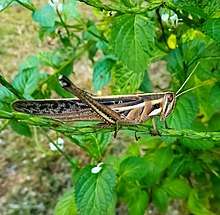Schistocerca pallens
Schistocerca pallens[5][6] is a large “bird grasshopper” in the subfamily Cyrtacanthacridinae[7] that occurs throughout tropical America. It is closely related to Schistocerca cancellata but shows no swarming behaviour or locust phase polymorphism, even under crowded laboratory conditions.[8] Although not a swarming locust, it can occur at sufficiently high densities to cause economic damage. It is mainly a pest of sugar cane, but has also been recorded as damaging almond, banana, beans, breadfruit, carnauba wax palm, chickpeas, coconut palms, cotton, forage crops, groundnuts, indigo, legumes, maize, onions, rice, sorghum, sweet potato and tomatoes.[9]
| Schistocerca pallens | |
|---|---|
 | |
| Scientific classification | |
| Kingdom: | Animalia |
| Phylum: | Arthropoda |
| Class: | Insecta |
| Order: | Orthoptera |
| Suborder: | Caelifera |
| Family: | Acrididae |
| Subfamily: | Cyrtacanthacridinae |
| Tribe: | Cyrtacanthacridini |
| Genus: | Schistocerca |
| Species: | S. pallens |
| Binomial name | |
| Schistocerca pallens (Thunberg, 1815) | |
| Synonyms | |
|
Schistocerca formosa Bruner, L., 1911[1] | |
Gallery
References
- Hebard (1923) Studies in the Dermaptera and Orthoptera of Colombia. Third paper. Orthopterous family Acrididae. Transactions of the American Entomological Society (Trans. Amer. Entomol. Soc.) 49:165-313, 8 pls.
- Rehn JAG (1908) Acrididae (Orthoptera) from São Paulo, Brazil, with descriptions of one new genus and three new species. Proceedings of the Academy of Natural Sciences, Philadelphia (Proc. Acad. Nat. Sci. Philad.) 60:12-23
- Walker F (1870) Catalogue of the Specimens of Dermaptera Saltatoria in the Collection of the British Museum, London 3:425-604.
- Bolívar I (1888) Enumération des Orthoptères de l'île de Cuba, Memoires de la Société Zoologique de France (Mem. Soc. Zool. France) 1:116-164
- Thunberg (1815) Hemipterorum maxillosorum genera illustrata plurimisque novis speciebus ditata ac descripta. Mémoires de l'Académie Impériale des Sciences de St. Pétersbourg (Mem. Acad. Imp. Sci. St. Peterburg) 5: 211-301.
- Harvey AW (1981) A reclassification of the Schistocerca americana complex (Orthopera: Acrididae) Acrida 10(2): 61-77.
- Roskov Y., Kunze T., Orrell T., Abucay L., Paglinawan L., Culham A., Bailly N., Kirk P., Bourgoin T., Baillargeon G., Decock W., De Wever A., Didžiulis V. (ed) (2014). "Species 2000 & ITIS Catalogue of Life: 2014 Annual Checklist". Species 2000: Reading, UK. Retrieved 4 February 2020.CS1 maint: multiple names: authors list (link) CS1 maint: extra text: authors list (link)
- Antoniou A & Robinson CJ (1974). Laboratory studies on the effects of crowding on phase and the life history of Schistocerca paranense (Thunberg)(Orthopera: Acrididae: Cyrtacanthacridinae). J. Nat. Hist. 8: 701-715
- COPR (Centre for Overseas Pest Research) (1982) The Locust and Grasshopper Agricultural Manual COPR; ISBN 0-85135-120-4.
External links


